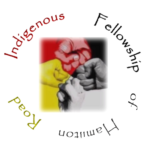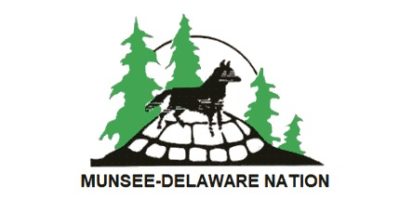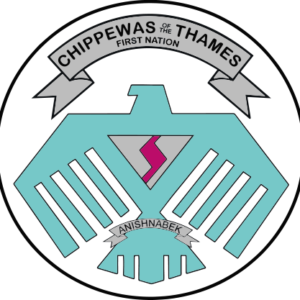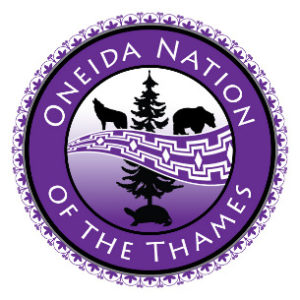Indigenous Fellowship of Hamilton Road

Surrounding Communities
The Indigenous Fellowship of Hamilton Road and the Mushkeeki Gitigan is located in Southwestern Ontario. While Southwestern Ontario is a vast territory. London is surrounded by three First Nations communities: Oneida Nation of the Thames, Chippewa of the Thames and Muncey-Delaware Nation. The Metis peoples of Ontario also reside in the Southwestern Ontario region.

Muncee-Delaware First Nation Reserve No. 1
Munsee-Delaware also call themselves Lenni Lenape and are one of several subgroups of Delaware, the Unalachtigo, the Unami, and the Minisink; later known as the Munsee. The Munsee-Delaware settled along the Thames River in the late 1700’s at the close of the American Revolution. Today they are creating employment for their youth by tapping into the emerging green energy industry within the region. The Nation operates a tree farm, Munsee Tree Corporation, which provides carbon credits for the market place. Other projects on the horizon include a mixed waste facility which will generate 15 MW of electricity, a solar farm, and associated training programs.
Total Membership: 547
Reference: Munsee-Delaware nation. Southern First Nations Secretariat. (n.d.). http://www.sfns.on.ca/munsee-delaware-nation.html
Chippewa of the Thames First Nation Reserve No. 42
We are the Anishinaabeg of the territory of Deshkan Ziibiing, also known as Chippewas of the Thames First Nation. We call ourselves Anishinabek which means the original people. Known as the Ojibway, who are a band of the Algonquin language family who originally migrated to the Great Lakes area from the north-eastern region of North America. Our political alliances are with the Odawa (Ottawa) and Bodaywadami (Pottawatomi) who together form the Three Fires Confederacy.
Chippewas is a forward thinking nation with a strong grasp of our traditional values. Through culture, heritage and continued education we are working towards a better future and towards being a self-governing First Nation. We are located on the north bank of the Thames River approximately 20 km southwest of London, Ontario. The majority of Southwestern Ontario is our modern traditional territory.
Total Membership: 2516
Reference: Home. Chippewas of the Thames. (2021, July 28). https://www.cottfn.com


Oneida Nation of the Thames First Nation Reserve No. 41
Oneida Nation of the Thames holds a unique position among the First Nation communities in Canada, in that we purchased our lands and arrived as settlers form New York State. Our original homelands are in the Madison County area of New York and well beyond. However, following the American Revolution, the Governor of NY, saw fit to reward returning American soldiers with parcels of Oneida lands. Documented from living memory of stories handed down (orature), money was thrown at the feet of Oneidas by the NY officials, telling them that this was payment for their lands and they should leave the state. Arrangements were quickly made between Oneida Castle and the Land Commission of Upper Canada to purchase the land in Delaware township along the banks of the Thames where we now reside in collective ownership. Two hundred forty men women and children arrived to the settlement in 1840 and each paid $42 to settle here. The settlement later became Reserve No. 41, after the Oneidas were unable to pay the huge debt of backtaxes most of which had been accumulated by the previous owners. Todays population is about 5700.
Total Membership: 6270
Reference: We are ONYOTA’A:KA, the people of the standing stone. Oneida Nation of the Thames. (2016, November 1). https://oneida.on.ca
Metis Peoples
The first Métis communities settled in the 1700s in the western Great Lakes regions, stretching between areas in the US and Canada (including Ontario, Wisconsin, Michigan, and Ohio). They later moved beyond this area when Europeans began to establish colonies there. The French Métis settled first along the trade routes of the Red River, while the English-speaking, or Anglo, people of mixed ancestry (sometimes also called Métis) settled around Hudson Bay, both in trading villages and corporate towns. While the cultural and linguistic distinctions between the French Métis and the Anglo Métis were more pronounced in the past, the two Métis communities have become more unified over time. The majority of Métis continue to live within what some call the Métis homeland, a loosely defined area along the former fur-trade route, which includes Manitoba, Alberta, Saskatchewan, Ontario, British Columbia, and the Northwest Territories. Métis individuals did not live on reserves, since they did not receive the official Status Indian designation that would have allowed them to join on-reserve bands.
Total City of London Self-Identified Metis: 1355
Reference: Métis. Facing History and Ourselves. (n.d.). https://www.facinghistory.org/stolen-lives-indigenous-peoples-canada-and-indian-residential-schools/historical-background/m-tis
